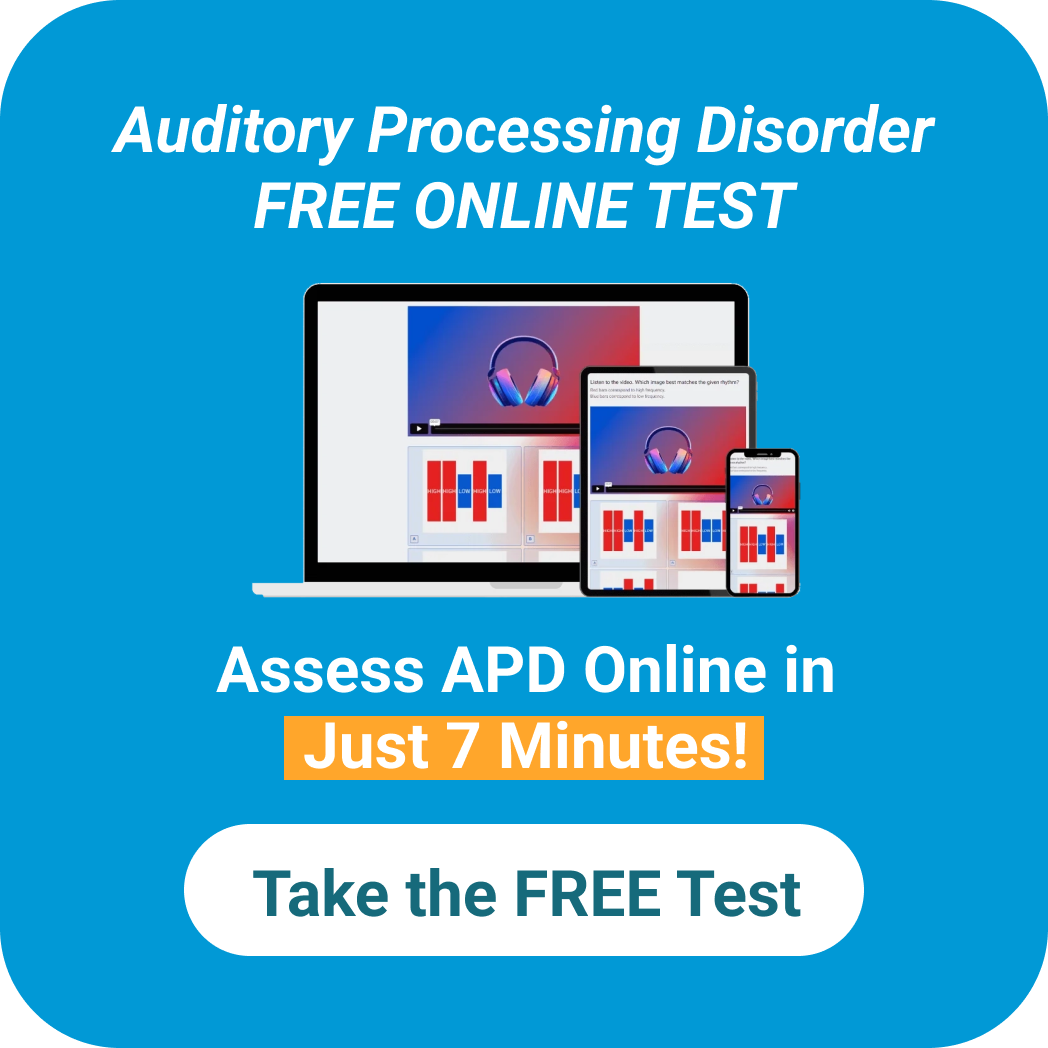Autism and Auditory Processing: Understanding the Impact, Challenges & Solutions
 Natalie Fitzgerald
Natalie Fitzgerald Speech-Language Pathologist
September 04, 2023

What is Auditory Processing Disorder? | APD in Children with Autism | Recognizing APD | APD Treatment Options for Children with Autism | Supporting Children with Autism and APD | Using Forbrain
Both children with auditory processing disorder and children with autism can have difficulty understanding spoken language. For children with auditory processing disorder, this difficulty comes from the brain’s trouble interpreting the sounds it hears. For children with autism, it may be because of a language disorder or sensory difference. Or, for some children, it may be both.
What is Auditory Processing Disorder?
Auditory processing disorder (ADP, also referred to as central auditory processing disorder) is a disorder of the hearing system that affects how the brain interprets what it is hearing. Around 2-5% of the population may have auditory processing disorder. APD is not the same as hearing loss and is not caused by hearing loss, is not a learning disorder, and is not related to the ability to understand meaning. Instead, in APD, the brain has trouble making sense of what it hears. For example, if someone said “Please go to the door.” a person with auditory processing disorder may hear “Please roll on the floor.”
Common characteristics of auditory processing disorder include:
- Difficulty understanding speech in background noise.
- Difficulty following multi-step directions.
- Mixing up word order in spoken language.
- Difficulty following conversations.
- Difficulty localizing sounds (knowing where a sound is coming from).
- Easily distracted by loud sounds.
- Difficulty listening for long periods of time.
- Frequently asking for repetition or clarification.
- Withdrawal for social situations due to frustration or fatigue.
Auditory Processing Difficulties in Children with Autism
Children with autism are more likely than neurotypical children to be diagnosed with auditory processing disorder. Children with autism often have difficulty with various auditory processing difficulties, including:
- Discriminating speech in background noise
- Listening when multiple people are speaking
- Following multi-step directions
- Understanding complex spoken sentences
- Perceiving pitch and intonation of speech
- Interpreting non-verbal cues and emotional displays through auditory cues
Autistic children with auditory processing disorder may also have poor academic performance, despite having average or above average cognition and language skills. They are further at risk for reduced interest in social communication due to the additional challenge of understanding spoken communication.
Why Recognizing APD Matters
Auditory processing disorder and autism are commonly co-occuring in individuals. When we have children with difficulty understanding spoken communication, it is important that we understand why they are having trouble. Knowing the underlying cause allows us to provide the best possible support and interventions.
Difficulty with auditory processing can impact multiple areas of development, including language, speech, and literacy. Children who do not understand language correctly are at an increased risk for both expressive and receptive language disorders or speech sound disorders. Children may have increased difficulty at school due to misunderstanding instructions or classroom directions. Furthermore, difficulty with sound discrimination can lead to trouble learning to read.
Auditory Processing Disorder Treatment Options for Children with Autism
There are various treatment options for auditory processing disorder in autistic children. Finding the right technique(s) for your child may take a bit of trial and error. What works for one child may not work for another. Some examples of techniques to use with APD and autism are:
Visual supports
Visual supports, such as visual schedules, written cues, or picture cards for different activities can be very beneficial for both autism and APD. Visuals have the benefit of both reducing frustration and confusion regarding verbal directions and can be used across settings. In a school setting, visual schedules are beneficial for transition periods to ensure students know what is coming next. Written cues are also very helpful for older children to use alongside verbally presented information.
FM systems
FM systems are devices that help to amplify (increase) one sound above other sounds. They are usually fairly simple, involving a microphone and a speaker. FM systems are commonly used in school settings for children with hearing loss, but there are benefits for children with APD as well. For a basic FM system, the teacher will wear a microphone and their voice will then be amplified through a speaker belonging to the child. This amplification can help children with APD focus on one sound over the background sounds.
RMHA systems
RHMA (remote microphone hearing aid) systems are hearing-aid like systems that involve the receiver wearing a small hearing aid and the speaker wearing a microphone. They are similar to FM systems, but instead of a typical speaker that may sit on a desk, the listener has the sound coming directly to their ear via the hearing aid. RMHA systems are helpful for children with autism and APD because they reduce the background noise and allow the child to directly hear the speaker’s voice with few distractions.
Dichotic auditory training
Dichotic listening is listening where both ears are competing with one another. For example, localizing sounds in a busy environment or following multiple conversations would involve dichotic listening. It is also an area where those with APD struggle. Dichotic auditory training works to help children with APD improve their dichotic listening abilities.
How to Support Children with Autism and Auditory Processing Disorder?
In addition to the techniques mentioned above, there are several strategies you can use at home. These are strategies that can help reduce sound anxiety, reduce environmental distractions, or otherwise help autistic children with auditory processing disorders better understand spoken communication.
Reduce background noise
One of the most simple and most effective things you can do for a child with both autism and auditory processing disorder is to reduce background noise. At home, this could mean turning the TV down (or off) before starting a conversation. In school, this could look like preferential seating to bring them closer to the teacher. By reducing background noise, you are giving the child the opportunity to focus on the speaker without having to filter out other unnecessary auditory information.
Use shorter, simpler sentences
Because many children with APD and autism have more difficulty understanding complex sentences, a simple way to help your child is to reduce the complexity. This does not necessarily mean using simpler language. Instead, this means breaking information into chunks that a child can process at a slower pace. For example, instead of giving a 3-step direction, give the same directions more slowly, with pauses between for processing time. Or, when having a conversation, use shorter sentences with pauses to convey the same information. It may take longer, but it is very beneficial.
Noise canceling headphones
Noise canceling headphones are an aid used to reduce overstimulation in noisy environments. They nearly completely block out environmental sounds, making them ideal for children who are more sensitive to sounds. Noise canceling headphones are commonly used in settings like the grocery store, amusement park, mall, or other places where they will hear multiple competing and/or loud sounds.
Loop earplugs
Loop earplugs are growing in popularity among the autistic and ADHD community. They are subtle earplugs that filter out background noise to reduce overstimulation in noisy environments. These earplugs can also help those with auditory processing disorder feel less fatigued in noisy environments.
The Benefits of Using Forbrain for Autism and Auditory Processing Disorder
Forbrain is an additional tool that can be used for children with APD and autism. Forbrain is an auditory feedback device that allows a person’s voice to reach their brain much faster than it would otherwise. It also allows the voice to be amplified to a slightly louder volume. This enhanced feedback speed and volume can be very useful for children with APD. With Forbrain children receive immediate feedback on the speech and language they are producing, which can help to improve their auditory processing abilities. Forbrain can be incorporated into various settings, including home, school, or therapy, and it does not have to be used all the time to be beneficial.
FAQ for Autism Auditory Processing Disorder
Is auditory processing disorder a form of autism?
No. Autism spectrum disorder (ASD) is a neurodevelopmental disorder that includes difficulties with social interactions, nonverbal communication, and repetitive behaviors. Many children also have sensory difficulties, including hypersensitivity to auditory information, or delays in expressive and expressive language. Though there are some overlapping characteristics between ASD and APD, and they are often co-occurring, they are separate conditions.
Who conducts an auditory processing evaluation?
If you are concerned your child may have an auditory processing disorder, you should consult with an audiologist. Audiologists are professionals who specialize in hearing disorders, and will rule out hearing loss or other functional ear problems before diagnosing APD. You can also take our free Auditory Processing Disorder test.
What are auditory sensitivities in autism?
As many as 95% of autistic children also have sensory differences. Some children are hyposensitive (under-responsive) to sensory information while others are hypersensitive (over-responsive). A hyposensitive child will typically crave different types of sensory input while a hypersensitive child will avoid it. Auditory sensitivities are present when children are hypersensitive to sounds. Things that are not too loud for others may be too loud for them, or sounds that others do not notice may distract them from focusing.
How does it sound for autistic child to have APD?
It depends on the child. Some individuals with APD report hearing the sounds in words wrong, such as hearing “The curl is praying” when someone says “The team is playing”. Other people report hearing everything less clearly, such as how the adults sound in the children’s cartoon Charlie Brown. Yet other people report only being able to correctly hear 1 out of every 2, 3, of 4 words that are said to them. For an autistic child, these difficulties may be further complicated by auditory sensitivities or receptive language delays.
How to communicate with someone with autism auditory processing disorder?
There are several tips for communicating with someone with ASD and APD.
- Use shorter sentences.
- Give frequent pauses when talking to allow for processing.
- Reduce background noise.
- Be accepting of social communication differences (such as reduced eye contact, turn-taking differences, or differences in inflection/intonation).
Final Words
Autism spectrum disorder (ASD) and auditory processing disorder (APD) are commonly co-occurring disorders that can cause reduced understanding of spoken communication. There are several techniques and strategies that can be used in therapy, schools, or home to help children with ASD and APD be more successful in understanding speech and language. If you have concerns about your child’s ability to hear or understand, please consult with a pediatric audiologist. If you are not sure where to find one, you can check out this tool on the American Speech-Language Hearing Association’s website. In the meantime, you may find some of the strategies listed in this article helpful for working with your child.
References
Johnston, K. N., John, A. B., Kreisman, N. V., Hall, J. W., Crandell, C. C., Johnston, K. N., John, A. B., Kreisman, N. V., Hall, J. W., & Crandell, C. C. (2009). Multiple benefits of personal FM system use by children with auditory processing disorder (APD). International Journal of Audiology, 48(6), 371–383. https://doi.org/10.1080/14992020802687516
Nagao, K., Riegner, T., Padilla, J., Greenwood, L. A., Loson, J., Zavala, S., & Morlet, T. (2016). Prevalence of auditory processing disorder in school-aged children in the Mid-Atlantic Region. Journal of the American Academy of Audiology, 27(09), 691–700. https://doi.org/10.3766/jaaa.15020
Ocak, E., Eshraghi, R. S., Danesh, A., Mittal, R., & Eshraghi, A. A. (2018). Central auditory processing disorders in individuals with autism spectrum disorders. Balkan Medical Journal, 35(5), 367–372. https://doi.org/10.4274/balkanmedj.2018.0853
O’Connor, K. (2012). Auditory processing in autism spectrum disorder: A Review. Neuroscience & Biobehavioral Reviews, 36(2), 836–854. https://doi.org/10.1016/j.neubiorev.2011.11.008






